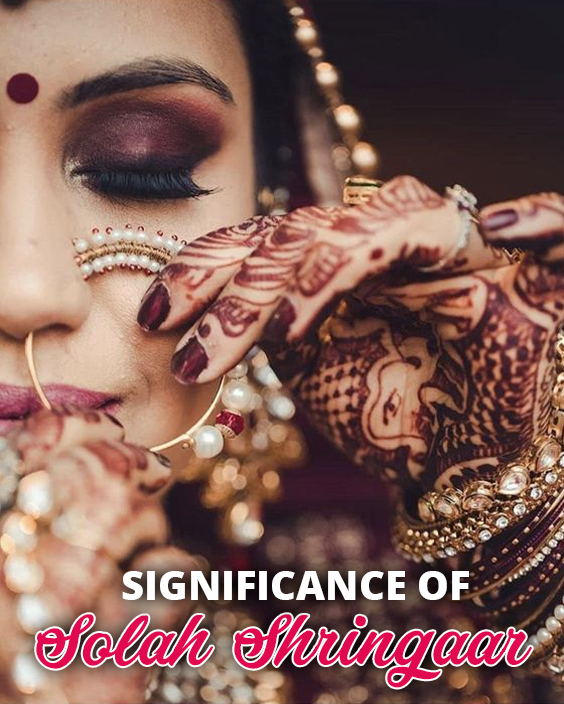Solah Shringar is said to enhance the beauty of the Indian bride during matrimony. The number 16 (Solah) is supposed to correspond to the various phases of the moon and Shringar is derived from ‘Shri’, Lakshmi. Matrimonial sites are now focusing on educating the modern woman about ancient traditions and embrace them.
1. Bindi:
It is the coloured red dot that women wear at the centre of their forehead; said to symbolise the elusive third eye-for wisdom, luck and prosperity.
2. Sindoor:
A red-coloured powder (usually kumkum) applied on the parting of the hair, considered auspicious for the well-being of her Indian groom.
3. Maang Tika:
The first piece of jewellery that goes on the Indian bride’s body, applied to the parting of the hair with a chain attached to the hair.
4. Kajal or Anjana:
A black dye preparation, generally applied to the eyes, said to protect and provide a cooling effect, accentuate the shape and beauty of her eyes and make it more alluring.
5. Nath:
Nath is worn through the left nostril by the bride on wedding and other auspicious occasions, sometimes with a chain that extends behind the left ear.
6. Karn Phool:
This is a must in an Indian bride’s matrimonial attire. Earrings usually elaborate, comes as a set with the bridal necklace.
7. Haar:
The Haar is to be worn around the neck, could be Sita-Haar, Choker. The most traditional haar is the mangalsutra, given by the husband on the matrimonial day and made of black beads.
8. Mehendi:
Applied to decorate the hands and feet of the Indian bride. The richness of the colour symbolizes luck, prosperity and fertility and provides a soothing effect on the skin.
9. Bajubandh:
The bajuband is an ornament to be worn on the upper arms, to have a slenderising effect on the arms.
10. Bangles:
Bangles are to be worn in forearms by the bride and come in variety of shapes and designs and materials.
11. Aarsi and Haathful:
Haathful comprises of four or five rings worn on the arm fingers with chains attaching them to a bracelet. Aarsi is a traditional thumb ring studded with a mirror, to allow the bride catch a glimpse of her groom in it.
12. Kamarbandh:
A gold or silver belt meant for the bride to wear around her waist. Traditionally, this was an ornament to secure the saree and emphasise the slenderness of her waist.
13. Payals:
Chains worn around the ankles, could be a simple or elaborate, may have a bunch of chiming beads attached. Wearing gold on feet is considered to be inauspicious, payals are made of silver.
14. Bichhua:
This is mostly worn on the second toe of the left feet, said to enhance fertility in married women and made of silver.
15. Fragrance/Sugandh:
Applied to the bride to smell pleasant throughout the wedding ritual, meant to soothe her nerves.
16. Keshapasharachana:
Traditionally, the hair bun is adorned with fresh, fragrant flowers along with other hair adornments, preferable gold.

